Touring 1906 Boston by Movie.
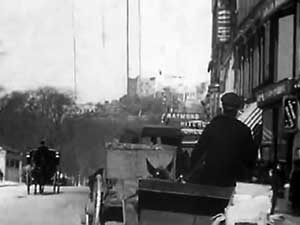
Imagine trying to describe your daily life to someone born in the year 2100. Someone who has never seen anything as dumb as a “smartphone,” except perhaps alongside adding machines and typewriters in a museum of antique technical curiosities. Someone who likely has never driven an automobile, but instead may rely on Venice-like boats and canals to get around a city whose streets have been reclaimed by the sea. Pretty challenging. Then think how much simpler the task would be if you could show that future person a video of your activities.
The situation, of course, is exactly the same when we try to understand the past. Words and pictures can describe things and places, but they can’t really impart the experience of being there. That’s why movies of everyday life from the early years of the 20th century are as fascinating to us as they were to the people who first saw them more than a century ago.
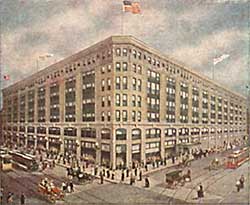
Movie Tours. Moving pictures were introduced in the 1890s. Soon producers were creating city tours by placing cameras on streetcars and filming as they drove. That way people in Indianapolis could tour Boston by visiting their local movie theater and vice versa.
Such a film was created in Boston in January 1906 when G.W. “Billy” Bitzer, an aspiring local cinematographer, took his camera on a streetcar through downtown and Back Bay. The film is only 7 minutes, but it gives us an opportunity to see people going about their daily business 110 years ago.
Take The Tour. A YouTube copy of the movie is embedded at the bottom of this page, or you can watch it directly on YouTube.
Boston in 1906. The city seen in the movie is very similar to and at the same time very different from the one we know today. Boston was the fifth largest city in the country and growing rapidly, but the regional population was much more concentrated within the central city than it is today. Certain Boston neighborhoods were among the most densely populated on Earth.
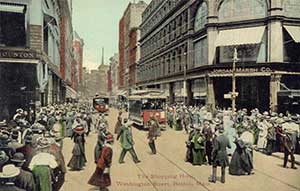
Much of the business and commercial infrastructure was new even though Boston is one of our country’s oldest cities. The subway had just begun running in 1897 and new buildings were continuing to fill the Back Bay. Many buildings downtown had recently been erected to replace those destroyed by the fire of 1872 (see Homeless Tonight: Boston’s Great Fire of 1872).
John “Honey Fitz” Fitzgerald was mayor; his grandson would be elected president in 1960. Gillette’s new safety razor company, which he founded above a fish store on Atlantic Avenue, was about to turn its first profit after selling just 51 razors and 168 blades in 1903.4
What to Look For. Chaos reigns in the streets. People, streetcars, horse-drawn vehicles and a few automobiles engage in free-for-all pandemonium. There are no stop signs, lane markers or speed limits.5 Boston didn’t install its first traffic lights until 1925, well after other major cities.6
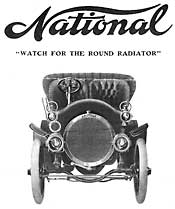
Electric streetcars are everywhere, many having been converted from horse power only a few years earlier. The horse-drawn vehicles range from delivery wagons to elegant carriages taking the well-heeled about town. A four-horse freight wagon is seen leaving North Station. Only two automobiles are seen, both parked, and there appear to be no bicycles.
For all the variety seen in forms of transportation, much less is evident in the people. Everyone is wearing a hat, the women are all wearing long skirts and the men neckties. And there appear to be few people of non-European descent. African-Americans made up two percent of Boston’s population in 1900, but only one is seen (1:31) amidst the throngs on Washington Street.
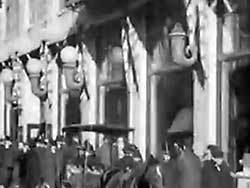
Start Downtown. The streetcar begins driving north on Tremont Street. Boston Common is on the left with the then new Boylston subway station.
The streetcar turns onto Boylston, goes a short block and then turns left onto Washington. A large building appears with a row of globe light fixtures over the first floor windows. That’s Siegel’s department store, which had just opened a few months before. It was huge (see color image above), 450,000 square feet (a typical Home Depot is 105,000), and employed 3,800 people. Moving stairs whisked people from floor to floor. They created some confusion, however, with some customers apparently thinking they were supposed to sit on the steps. Store employees were stationed at the top and bottom of each escalator to provide guidance.9
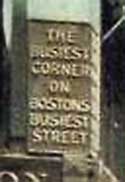
Notice the crowds. A clock shows 1:00 p.m. and it seems everyone is out shopping. A sign at the corner of Washington Street and Temple Place proclaims it to be “The Busiest Corner on Boston’s Busiest Street.”
Going down Washington Street we pass the venerable Jordan Marsh department store. On route to the Old South Meeting House we pass a waiting automobile with a circular radiator (2:13). It looks like a 1906 National (image above), the company’s slogan was “Watch for the Round Radiator.” With an advertised price of $3,000, it wasn’t for everyone. Henry Ford’s Model T was still 2 years in the future.
By North Station. The movie then skips over to the North Station area. On the right we see one of the early elevated streetcar lines. Continuing down Canal Street a large freight wagon is seen driving on Causeway, perhaps delivering items that had just arrived by train.
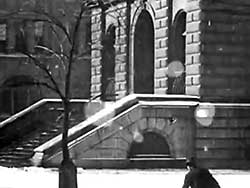
To Back Bay. The movie then jumps again, this time to Boylston Street in the Back Bay. The first building we see is the original home of M.I.T., which wouldn't move to Cambridge until 1917. The next building is MIT as well.
As the streetcar begins to turn onto Huntington Avenue, we see several buildings that remain Copley Square landmarks. The Old South Church with its bell tower is on the right and the then new (1895) Boston Public Library on the left. The tall building the behind the library is the Lenox Hotel, which continues to operate in the same facility.
Had the camera been turned to the left as it approached the library, we could have seen the Museum of Fine Arts’ original home. Going down Huntington Avenue we pass the Copley Square Hotel (still there) and end at Exeter Street, where the Prudential Center now stands.
* * * * *
At first glance, the world of 1906 seems quite remote from our own. But watch more closely and it becomes evident that things then were the same as they are today — some people were happy, others angry, some in a hurry, others not. They were running errands, going to appointments and meeting friends. Plus ça change … the more things change, the more they stay the same.
-----
- Seeing Boston, American Mutoscope & Biograph Co. (February 1, 1906) Catalogue H72715. See also, entry in American Film Institute Catalog of Feature Films.
- Image from postcard on Wikipedia.
- Postcard entitled The Shopping Hour showing Washington Street around 1910. Published by J. Valentine, New York. Image from Wikipedia.
- Timeline on Gillette company web site.
- Peter DeMarco, Unsafe at Any Speed, The Boston Globe (October 13, 2009).
- Clay McShane, The Origins and Globalization of Traffic Control Signals, Journal of Urban History, Vol. 25, No. 3, p. 383 (March 1999).
- Cover of sales folder for 1906 National, manufactured by the National Motor Vehicle Company of Indianapolis. Image from Chuck’s Toyland web site, which includes other images and history about the company.
- Seeing Boston at 0:48.
- Siegel’s New Store Opened, The Boston Globe, p. 4 (September 12, 1905).
- Detail from “The Shopping Hour” postcard.
- Seeng Boston at 5:09.
- Embedded from Pudgyv’s YouTube site.
This article originally appeared in our free semi-monthly newsletter. To receive future issues, please add your name to the subscription list.

